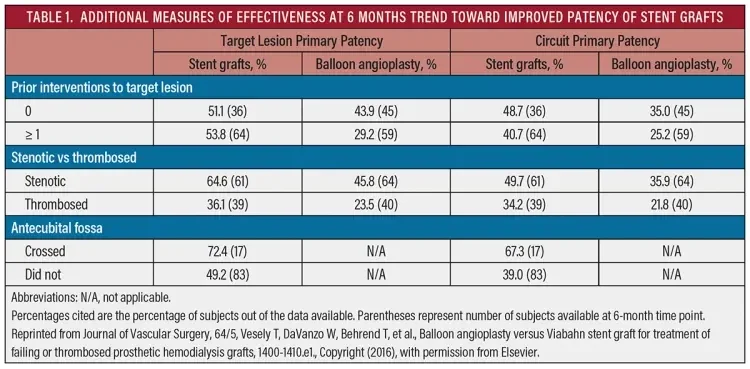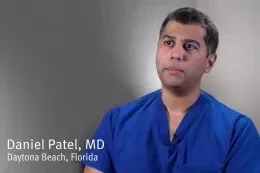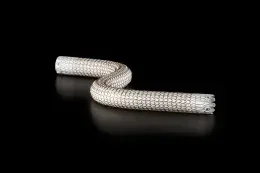Optimizing the vascular access circuit: Bringing long-term value to AV access creation and intervention
OPTIMIZING THE VASCULAR ACCESS CIRCUIT
Sponsored by Gore & Associates
Stent Grafts: An Important Tool in Today’s Dialysis Treatment Algorithm
Two dialysis experts discuss their approach to access challenges.
With John R. Ross, MD, and Ziv J. Haskal, MD, FSIR, FAHA, FACR
What are some of the common challenges you face as a physician when attempting to preserve and extend the life of a dialysis circuit?
Dr. Haskal: One is naturally having consistent and durable solutions for patients with surgically created permanent accesses. We know what to do with the venous anastomoses of arteriovenous grafts (AVGs), but how to provide similarly successful interventions in native fistulae remains a problem. We cannot support a care model wherein patients consistently return for autoreinterventions when global periods of reimbursement expire—we have to be better.
Another challenge is the persistent extended use of tunneled catheters in patients. Working to drive down the national use of catheters in patients awaiting access creation will translate to fewer infections, central vein stenoses, and the prototypical 25-year-old dialysis patient with end-stage central vein occlusions we all see. Finally, we’ve got to get in line and practice by evidence where evidence exists.
Dr. Ross: Graft-vein anastomosis is a recurrent problem, and balloon angioplasty alone has not been rewarding in this particular area. We are able to extend the life of that graft on the outflow side tremendously using the GORE® VIABAHN® Endoprosthesis. We also use the device in other areas, such as across the elbow where nothing else has shown the durability that we see with the GORE VIABAHN Endoprosthesis.
For those patients with reoccurring thrombosis, how have stent grafts like the GORE VIABAHN Endoprosthesis improved outcomes as a treatment option?
Dr. Haskal: We now have multiple prospective controlled trials proving the therapeutic and economic value of prompt use of expanded polytetrafluoroethylene (ePTFE) stent grafts in stenotic venous anastomoses. I’m proud to have designed and published first and subsequent work in this, so I’m a true believer. My randomized controlled trials did not include placing stent grafts in thrombosed grafts because we didn’t want to muddy the early data. The Gore REVISE trial included such patients and convincingly showed that a GORE VIABAHN Endoprosthesis provides a better outcome over angioplasty when treating a thrombosed graft, not just a stenotic one (Table 1). So, I use stent grafts in just this way.
Dr. Ross: There are three reasons that grafts thrombose, and they should be thought of as an inflow failure, an outflow failure, or a conduit failure. Assuming we don’t have an inflow failure or a conduit failure (other than thrombosis), and it's only related to the outflow, then in our experience, the GORE VIABAHN Endoprosthesis seems to do an exceedingly good job in maintaining patency for a much longer period of time than simple balloon angioplasties and certainly better than bare-metal stents (BMSs).
The data have shown stent graft improvements over percutaneous transluminal angioplasty (PTA), but what are your thoughts on drug-coated balloons (DCBs) as a treatment option in dialysis access?
Dr. Ross: Currently, we do not have convincing data on the treatment of graft-vein anastomosis associated with DCBs.
Dr. Haskal: I’m excited by the prospects of DCBs in AV access. I’m happy that we’ll see multiple prospective trials appear with different balloons and drug doses. Replicative studies are essential. Personally, I do believe there is a real signal for drug effect in this application of DCBs. I use them, but it’s the early days for this technology. Lead papers need to appear in full publication, subanalyses thereafter, and more real-world experience.
Regarding DCBs, what are your thoughts about data that have shown decreasing levels of improvement compared to traditional angioplasty over time?
Dr. Ross: DCBs have only completed one clinical trial. There seems to be a positive signal that there may be a future for DCBs in this area, but we need much larger studies to quantify what DCBs will do at 12 or 24 months. There seems to be some improvement over standard angioplasty balloons, but compared to stent grafts (and that’s where the comparison should be made), the benefit of DCBs is not definitive.
The clinical trial on DCBs, of course, did not use them with graft-vein anastomosis, only in fistulas. The graft-vein anastomosis may be a different pathological process, and as of now, we just don’t have any randomized controlled trial data. We do have some individual data from sites around the country that show much better results at the graft-vein anastomosis in thrombosed grafts—assuming we can say that the cause of the graft thrombosis was related to the outflow stenosis. If someone misses a problem with the inflow or doesn’t realize that there is a thrombogenic graft and is treating the outflow, it reclots, but it has very little to do with the outflow. If we know that it’s a stenosis at the graft-vein anastamosis that is causing the thrombosis, then certainly the GORE VIABAHN Endoprosthesis is enhancing patency and lengthening the period of time before we have a dysfunctional graft again (Table 1).1

Dr. Haskal: Here are some of the fundamental things to keep in mind: the reliable “binary” effect of the ePTFE stent graft in the AVG will never be matched by a DCB. We are not converting an end-to-side anastomosis to a laminar end-end one. We do not get the antirecoil effect of the stent graft when a balloon is used, drug coated or not. That means that the DCB effect will always be weaker and noisier, and may differ across anatomic areas. This means that we have to set appropriate expectations for DCBs. Significant improvement by DCBs over conventional balloons may be less dramatic, but still be enough on arteriovenous fistulae that stent grafts may have little or no role. There is no reason to believe that the anatomic responses to PTA and drugs will be similar in a cephalic arch as adjacent to the arterial anastomosis. It’s too early to tease apart these essential details. Patience and enthusiasm please, but neither blinded and unbridled, nor negative and dismissive.
Why would one not consider a BMS in the case of thrombosis?
Dr. Ross: BMSs have a tendency to get inside stent stenosis. It is a very aggressive stenosis that takes place. BMSs in veins, at least in AV access, seems to have gone by the wayside now. Stent grafts are going to be a way to actually prevent the recurrent stenosis. With BMSs, we are trading one complication for another complication, and the complication with a BMS may be greater than the complication than had we simply used PTA. The better outcome is going to be a covered stent.
Dr. Haskal: I’ve given a popular lecture entitled, “Requiem for the Bare Stent in Hemodialysis Access.” Thrombosis does not make a special case wherein a BMS might still be preferable. Consider that there are no modern controlled trials of BMSs against balloon angioplasty in the AV access circuit, nor will there be. There is no reason to hitch one’s product horse in a multimillion dollar regulatory study that will fail to show BMS advantage. The places for BMSs are few: central veins where a stent is required and a stent graft is problematic because of positioning challenges, jailing of traversed veins, or other technical aspects.
Describe the importance of device flexibility in situations where stent grafts are being used.
Dr. Ross: It is not infrequent that we place these devices across joints. We have a tremendous amount of flexibility with the GORE VIABAHN Endoprosthesis—we’ve used it across the elbow joint and certainly in the axilla, and I’ve never seen a fracture of a stent graft lattice in that environment at all. I think that has to do with a protracted patency.
Dr. Haskal: We need to be careful and specific when discussing device flexibility. The “finger bending” test we all do with a device handed to us is not a real test of performance. That caveat aside, I absolutely believe that flexibility matters, for example, at the antecubital fossa. All experienced operators have witnessed it. A flexible stent graft has unique benefit there, and I choose devices specifically for that flexibility when placing stent grafts there.
How do longer lesion lengths affect your decision when it comes to appropriate treatment?
Dr. Haskal: Stent grafts have allowed me to ignore lesion length. Access stent graft trials have not shown any patency impact with use of longer devices. This is entirely unsurprising, as the length of a surgical access graft does not directly impact patency—the quality of the downstream veins is much more important. This is the same in endovascular interventions. Twenty centimeter long venous stenoses or occlusions can be lined with ePTFE stent grafts and have truly long-term patencies, as long as the inflow and outflow veins (ie, the takeoff and landing strips) are of good caliber and free of stenoses. I’ve been practicing this approach for more than 8 years.
Dr. Ross: The longer the lesion, the greater the chance of recurrence. Generally speaking, when we see these long lesions, we’re looking at what I call the adequate outflow vein, which may be 10 or 12 cm away from a graft vein anastomosis. Typically on long lesions, angioplasty does very poorly, so we need another option. The GORE VIABAHN Endoprosthesis allows us, particularly with these long lesions, to reach far up.
How and where do you incorporate devices like the GORE VIABAHN Endoprosthesis into your treatment algorithms?
Dr. Ross: If we have a stenotic or occlusive lesion and we have difficulty in getting across with the wire, I like to put a stent graft there because the next time I may not be able to get a wire across and we may lose the access. Difficult wire passage certainly indicates to me that a GORE VIABAHN Endoprosthesis would have its place there.
If we have a long lesion, I think the GORE VIABAHN Endoprosthesis is going to be the first time around. If we have a stenosis that occurs early on after an access has been placed, I tend to use GORE VIABAHN Endoprostheses earlier, because the outcomes seem to be much better than just simple angioplasties. Any time that we are performing angioplasty, we always have a GORE VIABAHN Endoprosthesis in the room, just in case.
Dr. Haskal: Stenotic and thrombosed AVG anastomoses get stent grafts at initial meeting, unless (rarely) anatomically suitable. I do not delay or deny a patient the proven benefit of longer-term, better patency and the fewer reinterventions that we can guarantee with a stent graft. Cephalic arches move to stent grafts only after repeated angioplasties; I don’t hesitate to place flexible stent grafts thereafter. In-stent stenosis in BMSs is treated with stent grafts. Degenerating or unresponsive areas of native fistulae can benefit from stent grafts, if balloon intervals are unsuitably short and surgical alternatives are undesirable. Central vein lesions that require a stent are treated with stent grafts, unless sizes and anatomy aren’t suitable.
What is the importance of stent grafts like the GORE VIABAHN Endoprosthesis as it relates to the changing health care environment?
Dr. Haskal: Here’s some perspective: before stent grafts, angioplasty and other intervention patencies were described to 6 month endpoints. After stent graft trials, the endpoints have all changed to 2 year outcomes. We’ve long suspected the economic benefit of early stent graft use. I wasn’t able to publish those data with the first ePTFE stent graft trial even though our Monte Carlo simulations suggested that 10 years ago. But there are such data in favor of the GORE VIABAHN Endoprosthesis, and soon, for the BARD® FLAIR® Endovascular Stent Graft or BARD® FLUENCY PLUS® Endovascular Stent Graft. As physicians, we need to be sensitive to these data and act responsibility for cost control and better patient outcomes. When these go hand in hand, as with these devices in these applications, that’s a great place to be.
Dr. Ross: We’re looking at the time interval where we have a dysfunctional access, and even though the GORE VIABAHN Endoprosthesis may be fairly expensive up front, if we do not have to do another procedure within a short period of time, it actually becomes quite economical. It’s almost like a functional time ratio. If we can prevent a $10,000 or $15,000 procedure per year, hypothetically, then the GORE VIABAHN Endoprosthesis becomes very economical if it will buy us that particular amount of functional access over time.
In patients who have had critical access dysfunctions, the GORE VIABAHN Endoprosthesis is an integral part of the practice. It has been able to get us more time, and we hopefully will have patients undergo fewer additional procedures. In the future, when there is probably going to be some component of capitation, if the outcomes are very predictable as a function of time, then I think this is going to be one of the most important things that we can look at.
What future applications do you see for such devices in dialysis access?
Dr. Ross: We’ve been using the GORE VIABAHN Endoprosthesis for very difficult access since its launch around 2001.
I would love to see larger diameter GORE VIABAHN Endoprosthesis studied for performance in the central venous system. I would love to see a study on very large graft-vein anastomoses. A very important question that we need to answer is how cost will be a predictor of which device we’re using. If we’re getting the appropriate amount of time from the device, it may not be as expensive as it seems upfront when you look at that ratio.
Recommended Reading
Aitken E, Thomson P, Bainbridge L, et al. A randomized controlled trial and cost-effectiveness analysis of early cannulation arteriovenous grafts versus tunneled central venous catheters in patients requiring urgent vascular access for hemodialysis. J Vasc Surg. 2017;65:766-774.
Bittl JA, Cohen DJ, Seek MM, Feldman RL. Economic analysis of angiography and preemptive angioplasty to prevent hemodialysis-access thrombosis. Catheter Cardiovasc Interv. 2010;75:14-21.
Dolmatch B, Hogan A, Ferko N. An economic analysis of stent grafts for treatment of vascular access stenosis: point-of-care and Medicare perspectives in the United States [published online April 26, 2018]. J Vasc Interv Radiol.
Falk A, Maya ID, Yevzlin AS; RESCUE Investigators. A prospective, randomized study of an expanded polytetrafluoroethylene stent graft versus balloon angioplasty for in-stent restenosis in arteriovenous grafts and fistulae: two-year results of the RESCUE study. J Vasc Interv Radiol. 2016;27: 1465-1476.
Haskal ZJ, Trerotola S, Dolmatch B, et al. Stent graft versus balloon angioplasty for failing dialysis-access grafts. N Engl J Med. 2010;362:494–503.
Haskal ZJ, Saad TF, Hoggard JG, et al. Prospective, randomized, concurrently-controlled study of a stent graft versus balloon angioplasty for treatment of arteriovenous access graft stenosis: 2-year results of the RENOVA study. J Vasc Interv Radiol. 2016;27:1105–1114.e3.
Haskal ZJ. Time to purposefully plan ahead: a call for quality in research. J Vasc Interv Radiol. 2016;27:615-617.Mohr BA, Sheen A, Rodriguez A, Vesely T. Economic evaluation of the Viabahn stent-graft vs. angioplasty for \hemodialysis graft stenosis: evidence from the REVISE clinical trial. J Vasc Interv Radiol. 2015;26: S14.
United States Renal Data System. 2017 USRDS annual data report: Epidemiology of kidney disease in the United States. National Institutes of Health, National Institute of Diabetes and Digestive and Kidney Diseases; Bethesda, MD; 2017. https://www.usrds.org/2017/view/Default.aspx. Accessed May 14, 2018.
Vesely T, Siegel JB. Use of the peripheral cutting balloon to treat hemodialysis-related stenoses. J Vasc Interv Radiol. 2005;16:1593-1603.
Vesely, T, DaVanzo W, Behrend, T, et al. Balloon angioplasty versus Viabahn stent graft for treatment of failing or thrombosed prosthetic hemodialysis grafts. J Vasc Surg. 2016;64:1400-1410.e1
Products listed may not be available in all markets.
See all products by region:

John R. Ross, MD
Medical Director
Dialysis Access Institute
Orangeburg, South Carolina
Disclosures: Consultant to Gore & Associates.

Ziv J. Haskal, MD, FSIR, FAHA, FACR
Professor of Interventional Radiology, University of Virginia
Charlottesville, Virginia
Disclosures: Consultant to and received research support from Gore & Associates and Bard Peripheral Vascular/ Becton, Dickinson and Company



